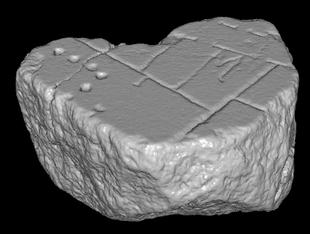
3D model of Fragment 492
INTRODUCTION TO THE DATABASE
This page introduces you to a database of the fragments of the Forma Urbis Romae. The database infrastructure, digital photographs, and 3D models are primarily the creation of Natasha Gelfand, David Koller, and Marc Levoy of the Stanford Computer Science Department. The text is researched and written by Tina Najbjerg and Jennifer Trimble of the Stanford Classics Department. This site is still under construction and we welcome your comments about the layout and content.To go directly to the database, click on the CONNECT TO DATABASE button below. This takes you to the index page of our database with a list of all the fragments and a search box. From there, click on any highlighted number to see the entry for that fragment. For information about the individual entries, how to download our 3D viewer, and how to use the search function, see below.